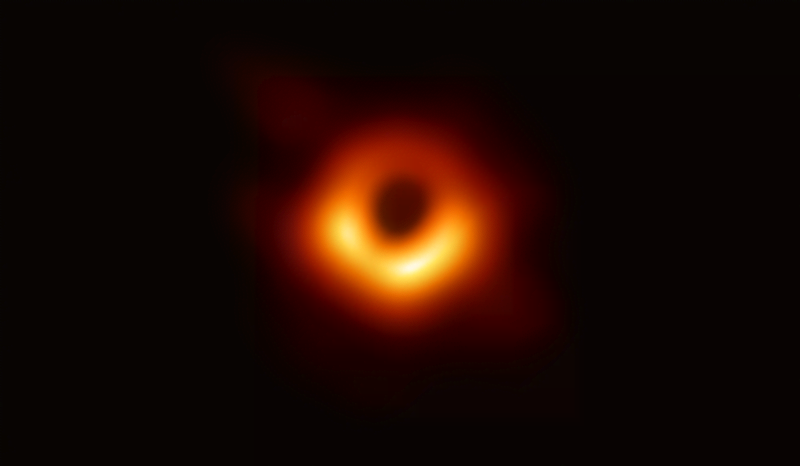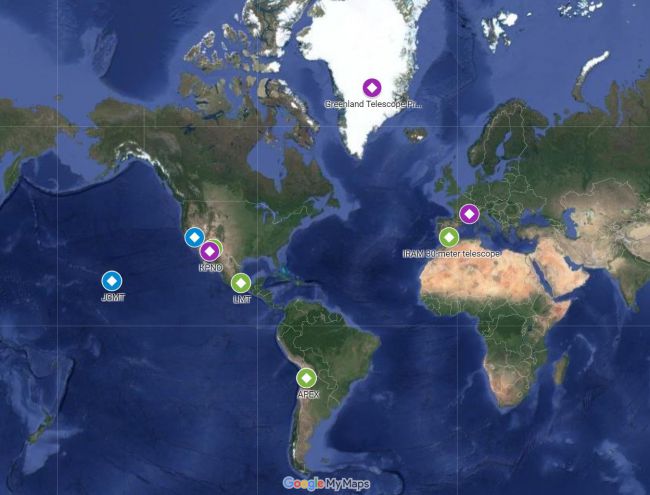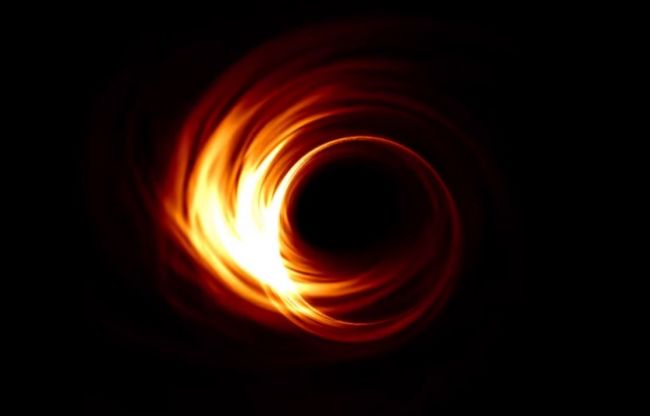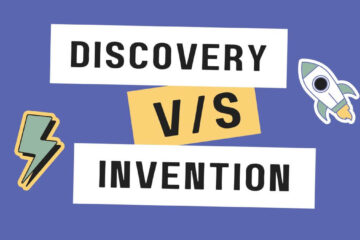Black Hole Image Congratulations, humanity! The first-ever REAL image of a black hole from the center of the galaxy M87 has finally been published today on April 10, 2019, by the scientists from the Event Horizon Telescope Collaboration terming it a groundbreaking result. We know that a picture is worth a thousand words and this photograph of a black hole would be an important tool for understanding astrophysics, cosmology and the role of black holes in the universe.
Are you ready to gaze at an actual photograph of a supermassive black hole!

Check More Clear Image of Black Hole – Polarized Image of Black Hole
Table of Contents
Real Black Hole Image -The breakthrough
This breakthrough was announced today in a series of six papers published in a special issue of The Astrophysical Journal Letters. The image reveals the black hole at the center of Messier 87 (M87), a massive galaxy in the nearby Virgo galaxy cluster. This black hole resides 55 million light-years from Earth and has a mass 6.5 billion times that of the Sun.
In addition to providing a picture that will quickly be incorporated into teaching materials around the world, the results helped to confirm (again) Einstein’s theory of general relativity, and it gave astrophysicists an unprecedented close-up of these enigmatic, dense celestial phenomena.
What is a Black Hole?
Black holes are a strange celestial phenomenon to describe. According to the theory of general relativity, black holes are made up of huge amounts of matter squeezed into a small area. They exert gravity that’s so powerful, not even light can escape their grip.
And despite how powerful our technology for observing space is these days, we’ve still never been able to snap a picture of a black hole but WE DID IT TODAY.
Why Black Hole is called ‘black’?
Around a black hole, there is a position of no return, widely known as the event horizon. It is termed ‘black’ because it absorbs all the light that hits it, reflecting nothing, just like a perfect black body in thermodynamics.
Black holes, the great gravitational beasts, emit no light in any part of the EM spectrum, so they themselves don’t look like much.
But astronomers know the objects are there because of a black hole’s entourage. Because of the black hole’s gravity which pulls in gas and dust, matter settles into an orbiting disk, with atoms jostling one another at extreme speeds.
All that activity heats the matter white-hot, at this stage matter emits X-rays and other high-energy radiation. The most voraciously feeding black holes in the universe have disks that outshine all the stars in their galaxies
You may also like to read-
- NASA’s Chandra X-ray Observatory
- Artemis Mission of NASA
- BepiColombo Mission to Mercury
- AstroSat discovered AUDFs01 galaxy
- Atmospheric Waves Experiment
What is Event Horizon?
In general relativity theory, an event horizon (EH) is a zone in spacetime beyond which events cannot affect an outside observer. And in layman’s terms, it is defined as the shell of “points of no return”, i.e., the boundary at which the gravitational pull of a massive object becomes so great as to make escape impossible.
Event Horizon Telescope
Event Horizon Telescope (EHT), a network of eight radio observatories spanning the globe, switched on in April 2017. Its mission is to peer out into space and attempt to snap the first-ever image of a black hole. The EHT had an announcement scheduled for Wednesday at 9:00 a.m. (Eastern Time), and nearly everyone was expecting to hear that the project has successfully captured the first-ever image of the black hole. And it did, finally.
Experimental Setup
The global experimental setup was a brilliant task the researchers had performed.
The Problem
The EHT team had to turn Earth into a virtual telescope platform. That’s because the power of a telescope to resolve images was limited to the size of its dish.
It was hard to see black hole shadows clearly because any images are blurred by interstellar gas, which presents a complicated challenge for the EHT team.
The Solution
By making an array of eight radio telescopes across the globe and combining the power of telescopes using Very-Long-Baseline-Interferometry, scientists effectively created a virtual telescope around the same size as the Earth itself.
By using an array of telescopes across the globe, the team of the researchers effectively broke up the dish and scattered the pieces of setup globally to make one big space eye in an attempt to deliver the first-ever image of the black hole.
The telescopes contributing to this result were Atacama Large Millimeter/Submillimeter Array (ALMA), Atacama Pathfinder EXperiment (APEX), the IRAM 30-meter telescope, the James Clerk Maxwell Telescope, the Large Millimeter Telescope Alfonso Serrano, the Submillimeter Telescope, the Submillimeter Array and the South Pole Telescope. Petabytes of raw data from the telescopes were combined by highly specialized supercomputers hosted by the Max Planck Institute for Radio Astronomy and MIT Haystack Observatory.

Targets of EHT
EHT had set its sights on a pair of behemoths comprising –
- Sagittarius A* – It is a supermassive black hole’s event horizon at the center of our Milky Way galaxy. It has a mass of 4 million suns and is about the size of the orbit of Mercury. Sagittarius A* is 26,000 light-years away from Earth.
- An even more massive black hole is 55 million light-years away at the core of the supergiant elliptical galaxy Messier 87. The supermassive black hole has a mass that is 6.5 billion times that of our sun.
M87’s black hole has an enormous mass, which gave researchers reason to believe it may be the largest viewable black hole from Earth. Black hole size is directly related to mass. The larger the black hole, the larger the shadow.
The Observations
All the observatories were synchronized to observe radiation emitted by the event horizon’s bright ring of material, which could help illustrate the silhouette of the supermassive black hole itself. They were turned on for just 9 days but managed to collect a wallop of data that has taken 2 years to transfer, process, and analyze in order to stitch together a visual of the object itself.
EHT has a resolution that can “count the stitches on a baseball 8,000 miles away.” The combination of eight telescopes improve an optical power 1,000-times that of the Hubble Space Telescope.
Computer simulations and the laws of gravitational physics gave astronomers a pretty good idea of what to expect. Because of the intense gravity near a black hole, the disk’s light would be warped around the event horizon in a ring, so even the material behind the black hole would be visible.

The image looks asymmetrical because gravity would bend light from the inner part of the disk toward Earth more strongly than the outer part, making one side appear brighter in a lopsided ring.
It’s hard to see black hole shadows clearly because images are blurred by interstellar gas.
Importance of Black Hole Image
At the project’s core, its 200 scientists wanted to answer two questions.
- The first is if photographing a black hole is possible.
- The second important thing they wanted to know if Einstein was 100 percent right about how black holes behave.
With today’s announcement, both these questions have been answered and fortunately, the response is positive in both the cases.
Einstein told us 100 years ago exactly what the size and the shape of that black hole’s shadow should be.
Way Forward
Researchers’ team aims to build models that would describe black holes in various circumstances.
In the work described at the 2019 SXSW festival, the scientists utilized Graphics Processing Units (GPUs), like the ones used in your favorite video game consoles or your computer, to model all the hypothetical varieties of a black hole environment. They generated hundreds of GBs of 3D volume data to model the possibilities. In a black hole’s forecast, photons, plasma, gas, and magnetic fields were all described.
As they have got the real image, the team can now compare the image of the black hole’s shadow to the different scenarios generated by the GPUs in order to make the most realistic simulation of how a black hole behaves, based on our current understanding of physics.
References (credit: EVENT HORIZON TELESCOPE )
Watch the following video on YouTube for the below-mentioned search.
- EHT: A Planetary Effort to Photograph a Black Hole (SXSW 2019 Panel)
- Event Horizon Telescope Animated Movie
We hope this article on real black on image helped you gain insight into the Black Hole and its recent developments. You may also want to check out other articles like this. If you liked the article and want to be notified for the next post, then please subscribe to the notifications by clicking on the ‘allow’ tab on the pop-up or by pressing the red bell icon on the bottom left side. You can also follow us on Twitter and Facebook for the latest updates.
Choose an option to read more.



0 Comments